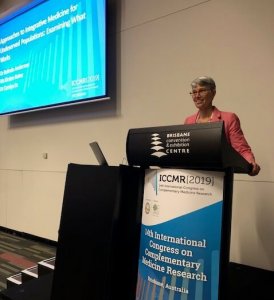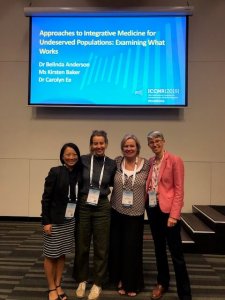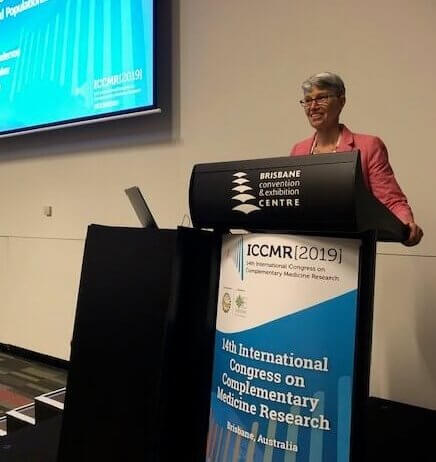 Belinda (Beau) Anderson, Ph.D., M.A.Ed., founding director of the Institute of Health and Wellness at Monmouth University, gave two talks and a poster presentation at the International Congress on Complementary Medicine Research annual conference held May 7-10 in Brisbane, Australia.
Belinda (Beau) Anderson, Ph.D., M.A.Ed., founding director of the Institute of Health and Wellness at Monmouth University, gave two talks and a poster presentation at the International Congress on Complementary Medicine Research annual conference held May 7-10 in Brisbane, Australia.
Her first talk was entitled “Comparative Effectiveness of Individual vs Group Acupuncture Therapy for Chronic Pain in an Underserved Population.” This talk focused on a large clinical trial she and colleagues at Albert Einstein College of Medicine, Pacific College of Oriental Medicine, and Montefiore Medical Center undertook exploring the effectiveness of acupuncture for chronic pain in an underserved patient population.
Seven hundred participants were treated in the study, which demonstrated that a low-cost acupuncture delivery model—group acupuncture that treats people in chairs in a group setting—is effective in significantly reducing pain severity and pain interference with activities of daily living.
“This research provides high-quality evidence that can be used by healthcare facilities to leverage offering this non-pharmacological approach to pain management,” said Anderson. “Such non-pharmacological approaches are desperately needed as the U.S. grapples with the opioid crisis, which currently results in 130 deaths every day and disproportionately affects people of low socioeconomic status.”
Anderson’s second talk was part of a panel presentation with researchers from Australia and was entitled “Integrative Medicine for the Underserved.” In this talk, Anderson outlined the somewhat unique circumstances in the U.S. that have led to the country being a leader in improving access to integrative medicine for the underserved.
She discussed the fact that healthcare in the U.S. is almost 20% of the gross domestic product (GDP), which is forcing an increased interest in preventative health, and the use of reimbursement models based on healthcare quality and prevention.
The opioid crisis has led to several U.S. agencies recommending non-pharmacological interventions to be the first line of care for pain management, according to Anderson. These agencies include the National Institutes of Health (NIH), the Center for Disease Control and Prevention (CDC), the Food and Drug Administration (FDA), the American College of Physicians, and The Joint Commission, which accredits all hospitals and healthcare facilities in the U.S.
Anderson added, “There is now a critical mass of research evidence demonstrating the effectiveness of integrative medicine, which has been used to leverage increased usage within conventional medical settings. It is now used widely by the U.S. Department of Veterans Affairs and the U.S. Department of Defense.”
Her poster presentation, “Interdisciplinary Relationship Models for Complementary and Integrative Health: Perspectives of Chinese Medicine Practitioners in the United States,” reviewed a qualitative study that Anderson and colleagues just published describing the opinions and perspectives of experienced acupuncturists about the most ethical model for combining complementary and integrative therapies with biomedicine within interdisciplinary healthcare settings.
The majority of acupuncturists preferred pluralism, where different approaches to healthcare co-exist in parallel.
“Pluralism is based upon a foundation of cooperation, open communication, and respect between practitioners, despite the possible existence of honest disagreement,” said Anderson. “This model uses research evidence to determine the most optimal intervention, and preserves the integrity of each of the different treatment systems.”
The International Congress on Complementary Medicine Research is the preeminent annual research event convened by Endeavour College of Natural Health in Australia in association with the International Society for Complementary Medicine Research and leading research institutions around Australia. The theme of the this year’s conference was “Pathways and Partnerships.”
Additional Links

